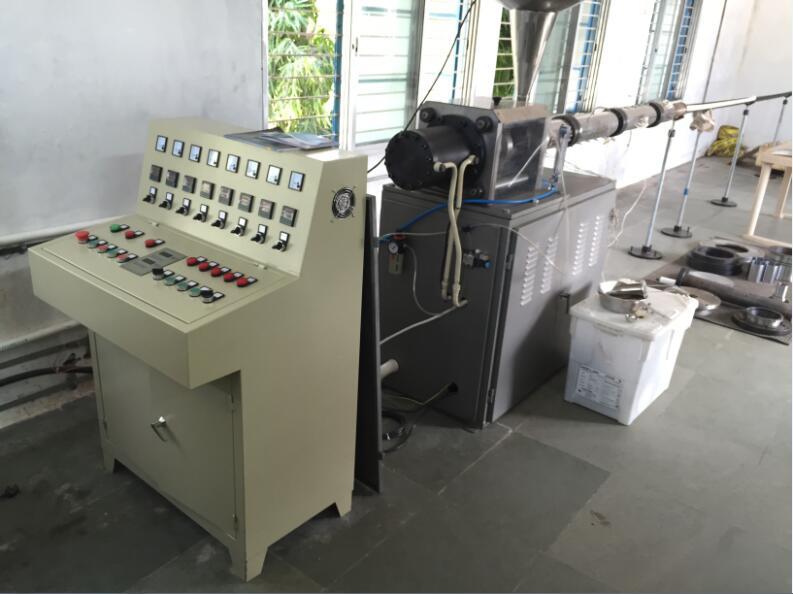Thermoplastic polymer reactive extrusion (hereinafter referred to as reactive extrusion) refers to the screw extrusion equipment for reactor, reactants and necessary for complete reaction initiator, catalyst and other materials under certain reaction conditions through continuous extrusion screw extrusion equipment, and complete the scheduled chemical reaction, get the corresponding polymer process.
Thermoplastic polymer reactive extrusion (hereinafter referred to as reactive extrusion) refers to the screw extrusion equipment for reactor, reactants and necessary for complete reaction initiator, catalyst and other materials under certain reaction conditions through continuous extrusion screw extrusion equipment, and complete the scheduled chemical reaction, get the corresponding polymer process. It usually includes two kinds of reactions: first, thermoplastic polymers introduce corresponding chemical reactions in the continuous extrusion process to chemically modify the polymers or prepare new polymers; Second, the monomer is polymerized during continuous extrusion to form thermoplastic polymer. this paper, the basic principle, reaction type and application of reactive extrusion and the related equipment of reactive extrusion are introduced emphatically.
Research on reactive extrusion is very active in industrial laboratories and resin and extruder manufacturers in Europe, America and Japan. In the past 20 years, more than 1000 patents have been filed abroad. Reactive extrusion has become one of the main methods for chemical modification of polymers and development of new polymer materials.
Through screw extruder on the reactive extrusion process of reactor, whether it is a single screw and twin screw extruder, and other types of extruder, its basic steps are: reactants, including catalyst and initiator by screw extrusion tail department and in the middle of the feeding mouth into the screw barrel, rely on the screw rotation shear and promote mix materials are scattered and move forward. At the same time, heat is provided to the reaction system through the heat transfer of the screw cylinder, or heat generated by the reaction is eliminated from the reaction system, so as to control the start, progress and termination of the reaction. The final product is extruded from the front head of the screw extruder. Therefore, this process has the following characteristics:
- 1.With screw extruder barrel can delay the axial according to the need to set up several feeding mouth, so all kinds of reactants, including polymers and monomers, as well as the catalyst, initiator and other materials can be according to the laws of the various chemical reaction itself, along the screw axial according to certain procedures and the most appropriate way to join step by step, in order to achieve the control of chemical reaction at predetermined sequence and direction.
- 2.As the chemical reaction in the extrusion process is the same as that in other methods, it is carried out under a certain temperature. The reaction may be endothermic or exothermic. However, the screw extruder can be heated or cooled in sections along the axis of the screw, so it is possible to control the temperature accurately in sections during the reactive extrusion process. In this way, not only can the optimal reaction start and stop time be controlled by temperature accurately, but also the direction, speed and degree of reaction can be controlled by temperature distribution along screw axis and distribution gradient according to the characteristics and laws of chemical reaction itself, so as to reduce the occurrence of side reactions.
- 3.As screw extruders, especially twin-screw extruders, have strong mixing capacity, they can continuously update the phase interfaces of different materials in the molten state, as well as the interfaces between materials and barrel. Therefore, the mass transfer and diffusion between the reaction components of the high viscosity polymer system were enhanced, and the mixing uniformity of the reaction material system was improved. At the same time, this mixing process also reduces the temperature gradient along the radial direction of the screw inside the reaction material system, which makes the whole reaction more uniform and consistent. Especially for the reaction process of some chemical modification of polymer, this kind of reaction usually needs to be carried out under the condition of high viscosity polymer melt body from the beginning of the reaction, at this time, reactive extrusion method should be the first choice for this kind of chemical reaction.
- 4.For the screw extruder, the residence time and residence time distribution of the reactive material can be controlled within a certain range by adjusting the rotation speed of the screw and the geometric structure of the screw. The slower the rotation speed of the screw, the larger the length-diameter ratio and the longer the residence time. Since the screw speed is proportional to the shear rate, or to the mixing effect, it cannot be too slow. Meanwhile, the length-diameter ratio of screw can not be infinitely large. Therefore, the residence time of reactive extrusion process is generally short, which means that reactive extrusion is more suitable for a kind of chemical reaction with high reaction speed. For this point, from another perspective, it can be considered that the thermal history of chemically modified polymers by reactive extrusion method is generally short, which avoids the thermal decomposition caused by long-term exposure of materials to high temperature.

Post time: Aug-05-2019

